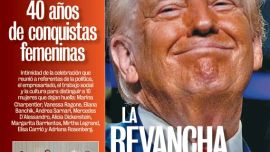Through his work at the Herald, Cox – a Times columnist – managed to save lives and pressure the dictatorship, long before the horrific nature of their crimes became public knowledge.
The film’s director, Australian journalist and former Herald staffer Jayson McNamara, talked to the Times this week about making the documentary, working with Bob Cox and finding a way around Argentina’s political divide.
Ripping off the band-aid from the start, what was it like to have your documentary released in the BAFICI competition amid ramping rumours about the Herald’s impending demise and then to publicly release it in theatres after the newspaper ceased its 140-year run?
I don’t think the closure of the Herald was a surprise for those of us who had been in contact with the paper in the past few years. It would have been naive to imagine the eternity of a newspaper published in English given the financial difficulties that even big, mainstream papers face. The closure of the paper has generated more interest in the film, that’s for sure.
As a Herald staffer at the time, what made you turn your attention and efforts on filming Bob Cox’s story and his epic stand, at the helm of the newspaper, during the last military dictatorship?
It was a very surreal experience discovering the story while I was working in the newsroom. I think that having a personal connection to the paper was enough to encourage me to move forward with my plans, knowing that I could easily turn to my colleagues for advice and even for simple, practical things like getting Bob Cox’s email address. Then, once I got started, I became quite obsessed with the Cox-Herald story and it was a nice feeling to know that our project might one day reach the place it has reached today, which is essentially an opportunity for us to share the story more broadly and shine a light on some remarkable journalism and some remarkable human beings like Bob.
How long did you work on the documentary and what were your main challenges in terms of finding footage and testimonies?
The film took three years to finish, we began in early 2014. Our biggest challenges were time and money — that’s essentially the case for all independent films. Fortunately, the latter came along and we were able to buy the former. The hunt for archival footage was something I undertook in my free time when I was still working at the Herald (I left in late 2014) and we filmed, on average, one interview per month over 14 months. I really can’t complain. I received so much support and good will throughout the project. I feel very fortunate.
How was your first contact with Cox when you approached him about your film project?
Very natural. Bob is a simple guy. He and his wife Maud invited me over to have a cup of coffee one day and I told him about my idea, which at that stage was quite underdeveloped. We had a couple more meetings and soon after, my team and I were knocking at the Coxs’ door with lights, cameras and tripods.
How was working with Cox and what have you learned from him during the making of this film? Are there any anecdotes that stayed with you long after shooting a scene?
I tried to keep Bob as informed but as distanced as possible from the inner workings of the project, so that he felt comfortable with what we were doing but didn’t overthink any particular lines of investigation that we were developing. From the point of view of a documentary filmmaker, I think Bob is a dream protagonist. We had a lot of fun with him and Maud, they would often welcome us with sandwiches and coffee when we visited them to film. A particularly interesting day was when, one Saturday in late November, we went out filming in Plaza de Mayo and the Costanera. It was so cold that day that I was shaking. Everybody was terribly underdressed except Bob. We got some great footage and I remember thinking how Bob seemed like one of us. He’s an old soul with the optimism of a man half his age.
You are Australian-born and have been living here for four years. Taking on this era of Argentine history as a foreigner must have posed some challenges. How did you go about it, both during the research and the testimonial interviews?
The dictatorship era is a difficult period to cover because it continues to shape all aspects of Argentina’s social and political life. Naturally people are very sensitive about how it’s interpreted and reinterpreted. I never felt any hostility or rejection for being a foreigner (perhaps because I’m neither English nor American) but occasionally I could feel myself getting caught up in a sort of tug-of-war in which people try to convince you of one point over the other. I took my time to investigate and was very cautious about how and what issues I touched on.
In addition to images from the Trial of the Juntas, the film features archive footage from the BBC, the public TV stations of Germany, the Netherlands and Finland, most of which had never been shown before in Argentina. How did you come about it and how difficult was it to get this footage?
In some cases it was too much of a nightmare to work through the bureaucracy of some of the European broadcasters’ archives and too expensive to pay for US footage. I must take the opportunity to salute Beeld en Geluid in the Netherlands and YLE in Finland, especially, for their commitment to protecting and organising their archives.
They’ve done a marvellous job and it’s all fairly straightforward to access. There is so much material on Argentina in Northern European televisions’ archives! I hope other filmmakers have the opportunity to access and use it in their projects.
How did you go about interviewing key witnesses like the Grandmothers of Plaza de Mayo and the other Herald journalists who worked with Cox at the time?
My colleagues at the Herald were a huge help in this regard, especially when it came to contacting certain people. This was perhaps just an excuse to meet some extraordinary people. I’ll never forget having lunch with Chicha Mariani (one of the founders of Grandmothers of Plaza de Mayo). It was just me and her one afternoon in her home. It’s such a thrill to have those opportunities. It’s something I’ll never forget.
How do you want this film to resonate with audiences on both sides of the political divide, especially given the difficult position in which journalism finds itself today?
I think it’s important not to get too excited about a film like yours, which is exceptional in the sense that it seems to generate consensus among people who are otherwise divided politically and ideologically. But I do hope that it serves as a message that there are ways to work around the so-called “grieta” and it starts with being respectful and sensitive with certain issues. You often hear in Argentina, “We need to come together, we need to close the gap that divides us,” but from people who at the same time are subliminally telling you, “but only if you agree with me and my views.”
Journalism in Argentina seems to boil down so often to who can yell the loudest or who has the sassiest headline. There’s a void which needs filling, and perhaps documentary projects can be a part of filling it.
WHEN AND WHERE
Messenger on a White Horse/El mensajero screens twice daily, 12.15pm and 7.30pm at the Gaumont (Rivadavia 1635) and every Friday of October at 9pm at Amigos del Bellas Artes (Alcorta 2280).


























Comments